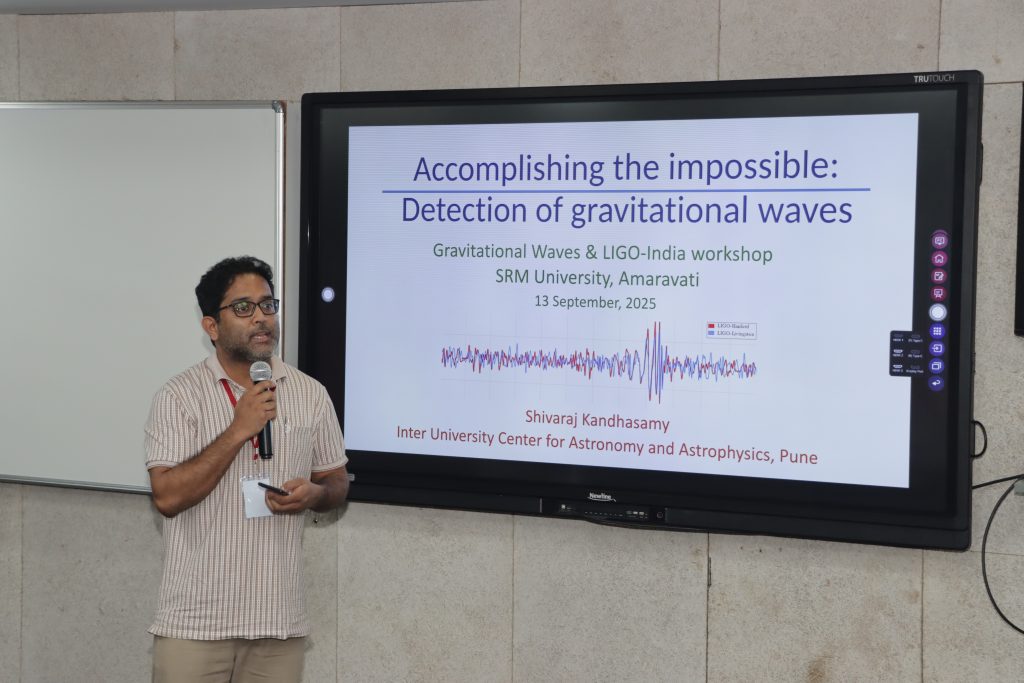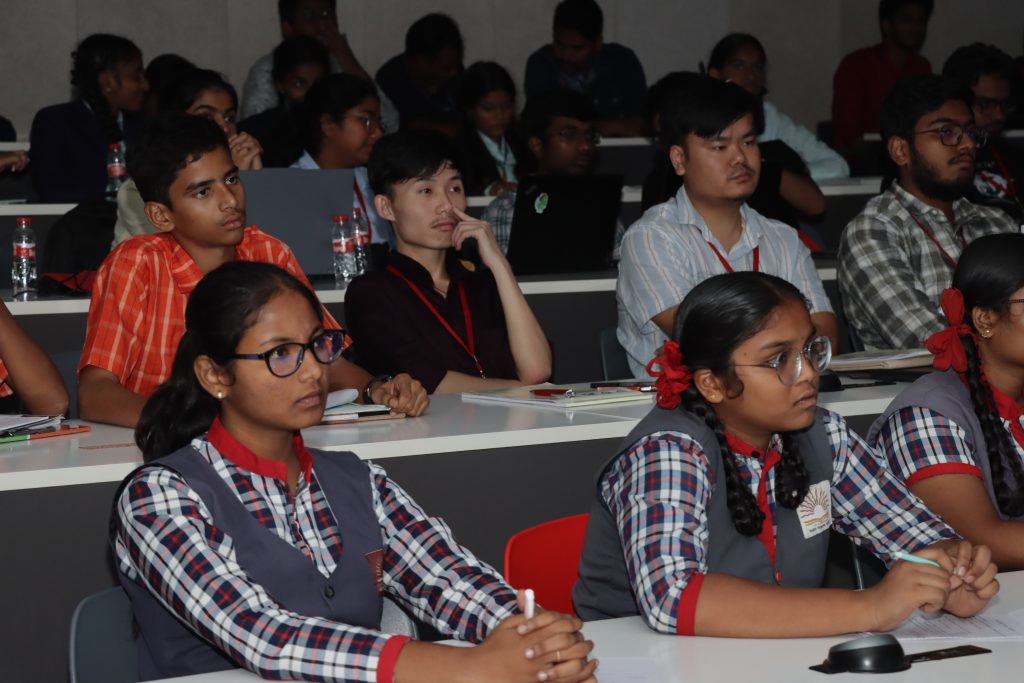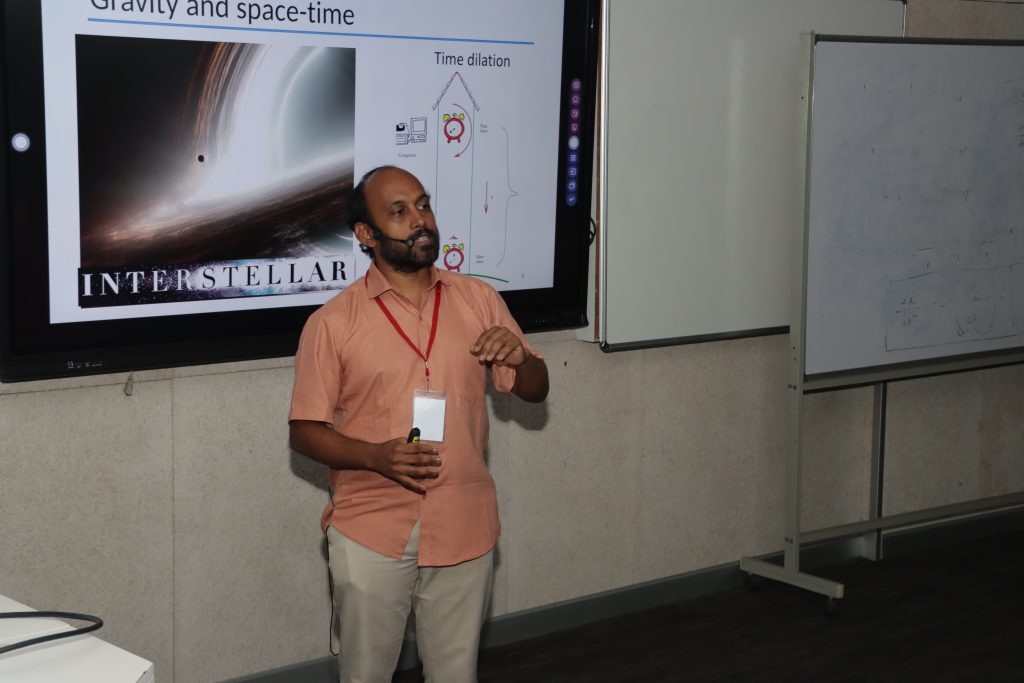Recent News
- “Phy-Spark 3.0” – Igniting a Passion for Astrophysics September 15, 2025
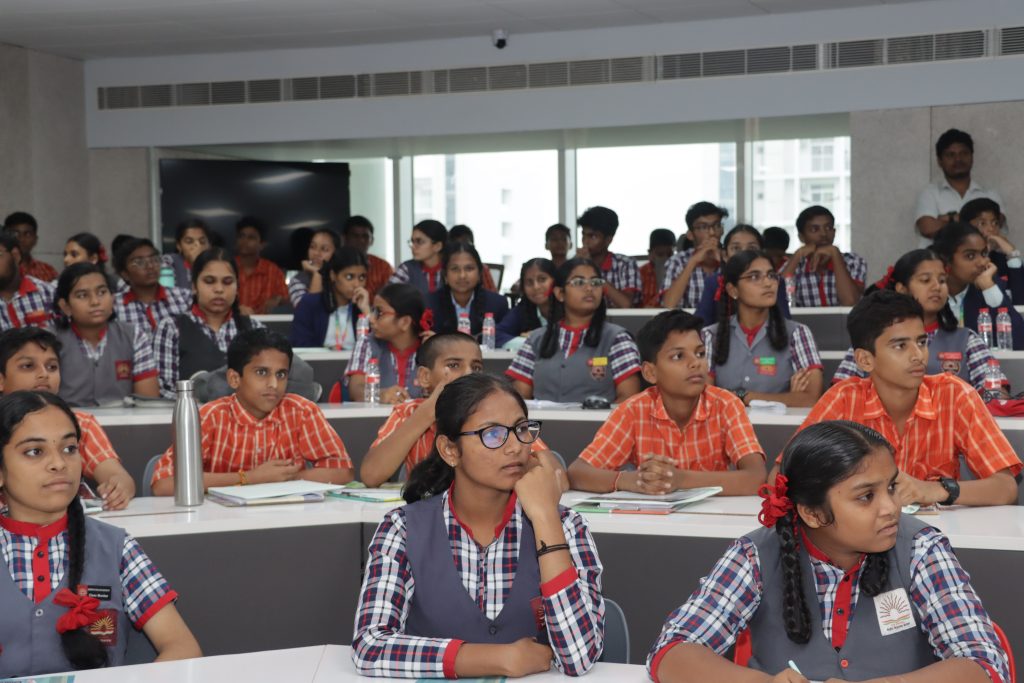
SRM University-AP hosted Phy-Spark 3.0: Stars, Scopes & Spacetime on September 13, 2025, as an outreach initiative for school students. A combination of lectures, experiments, demonstrations, and interactive sessions took place throughout the day-long programme introducing young students to the exciting fields of physics and astrophysics. 120 students from Geethanjali School, Kunchana, K V School, Nallapadu and Vijetha School, Guntur participated in the programme.
A public lecture delivered by Dr Shivaraj Kandhasamy, renowned scientist from the Inter-University Centre for Astronomy and Astrophysics (IUCAA), Pune, on the Detection of Gravitational Waves by LIGO was the highlight of the programme. Dr Kandhasamy explained how gravity shapes the fabric of spacetime and introduced the concept of gravitational waves. He walked through the historic Michelson-Morley experiment, the design and functioning of the Laser Interferometer Gravitational-Wave Observatory (LIGO), and the challenges of detecting such incredibly faint signals. The lecture also covered landmark detections, including gravitational waves generated from black hole mergers and binary neutron star collisions.
Expert faculty members Dr Gangireddy Salla, Dr Ashmita Das, and Dr Krishna Prasad Maity from the Department of Physics of SRM AP delivered academic sessions on several intriguing topics such as Telescope: Fundamentals and Designs, Binary Star Systems and General Theory of Relativity. The lectures were followed by a lab visit and live demonstrations of telescopes, binary star experiment using LED bulbs, Michelson interferometer etc., and an interactive Q&A session facilitating hands-on experiential learning on astronomical observations, scientific equipment, and the application of ideas they had learned in theory.
The programme conducted to ignite the spirit of learning physics among the budding minds of school students was a resounding success. Through Phy-Spark 3.0, SRM University-AP successfully made complex concepts in physics and astrophysics accessible to school students providing them with a glimpse of how physics is applied in real-world research environments. The event was coordinated by Dr Pranab Mandal, Dr Gangireddy Salla and Dr Soumyajyoti Biswas of SRM AP.
Continue reading → - Dr Barman on Hunting for heavy Z ′ August 31, 2025
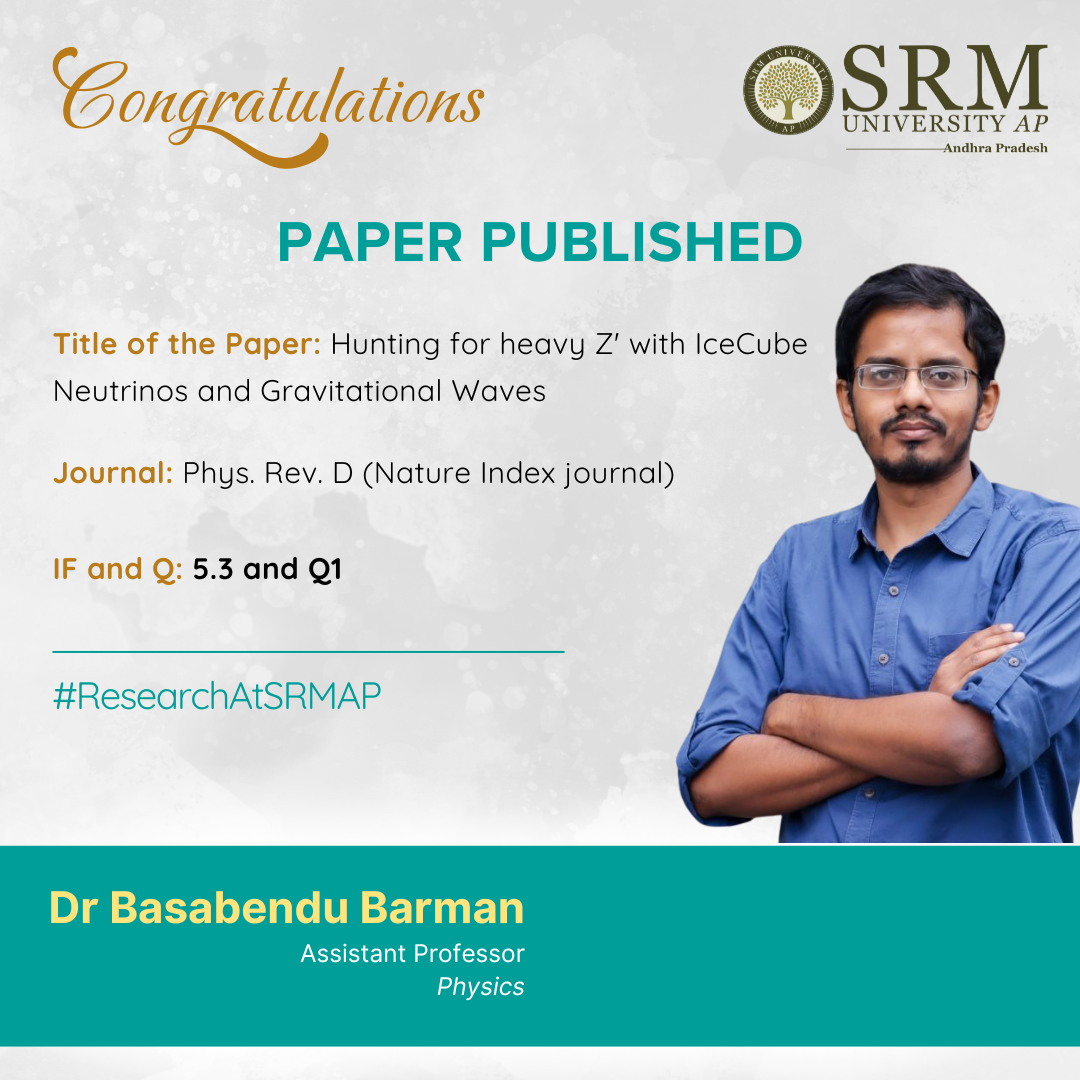 This research article, “Hunting for heavy Z ′ with IceCube neutrinos and gravitational waves,” by Assistant Professor Dr Basabendu Barma, explores the links between dark matter, the imbalance of matter and antimatter in the universe, and how these phenomena might be detected through various methods.
This research article, “Hunting for heavy Z ′ with IceCube neutrinos and gravitational waves,” by Assistant Professor Dr Basabendu Barma, explores the links between dark matter, the imbalance of matter and antimatter in the universe, and how these phenomena might be detected through various methods.Abstract:
In the minimal gauged B−L extension of the Standard Model, we demonstrate that PeV-scale dark matter (DM) and the baryon asymmetry of the Universe (BAU) can be simultaneously explained through the three right-handed neutrinos (RHNs) present in the theory. The DM candidate undergoes rare decay into light neutrinos, providing an explanation for the observed IceCube events, while the other two RHNs generate the BAU via leptogenesis. The breaking of gauge symmetry gives rise to detectable gravitational waves (GWs) from decaying cosmic strings (CS), making this framework testable at several future GW detectors—despite being beyond the reach of conventional collider experiments due to the extremely weak gauge coupling. The symmetry-breaking scale establishes a connection between particle masses, couplings, and the GW spectrum, offering a unified and predictive scenario.
From the Layman’s Perspective:
We know there are four fundamental forces in nature: strong, weak, electromagnetic, and gravitational. But what if there’s a hidden, fifth force we haven’t discovered yet? The Standard Model of particle physics, which organizes all known particles, doesn’t include this fifth force (and doesn’t include gravity either, unfortunately). So, how can we theoretically create a particle physics model for this possible fifth force? That’s what we explore in this paper.Interestingly, there are already experiments (for example, the Large Hadron Collider or LHC at CERN, Geneva) searching for signs of fifth forces. If this force exists, our model could be tested by these experiments. But there’s more! We also wanted to tackle a big mystery in cosmology: dark matter. Dark matter makes up about 24% of the universe, but we’ve never directly detected it because it doesn’t reflect light—it’s “dark.” However, there are smart ways to try to find it. In this paper, we propose how the same dark matter might interact with the visible universe through this fifth force and thereby leave their footrpints at IceCube experiment that looks for high energy neutrinos or at experiments that search for “spcaetime ripples” called the gravitational waves.
Practical Implementation & Social Impact:
This work primarily contributes to the realm of pure intellectual pursuit. Science speaks the language of data, and data is born from experiments. The validation of any well-constructed theory ultimately depends on experimental evidence. For this reason, it is essential for society to cultivate a culture that values fundamental scientific discussion and increases funding for basic research.
Collaborations:
This work has been done in collaboration with Arindam Das (Hokkaido U.), Suruj Jyoti Das (IBS, Daejeon, CTPU), Marco Merchand (Royal Inst. Tech., Stockholm and Stockholm U., OKC).
Future Plans:
A closer look into early universe dynamics by performing more involved simulations.
Connection between particle physics models and early Universe cosmology. Complementary searches from different experiments in unraveling new physics beyond the Standard Model. Searching new physics at energy and intensity frontier
Continue reading → - Teacher-Student Duo Research on Dark Matter Model June 16, 2025
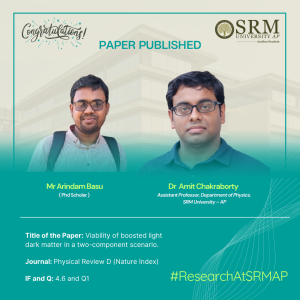 As a significant contribution to science, Assistant Professor Dr Amit Chakroborty and his Doctoral Scholar, Arindam Basu, from the Department of Physics have published a groundbreaking paper titled, Viability of boosted light dark matter in a two-component scenario in the Physics Review D (Nature Index ) Journal. The research explores a two-component dark matter model and addresses the theoretical challenges in hopes of improving our understanding and painting a complete picture of dark matter.
As a significant contribution to science, Assistant Professor Dr Amit Chakroborty and his Doctoral Scholar, Arindam Basu, from the Department of Physics have published a groundbreaking paper titled, Viability of boosted light dark matter in a two-component scenario in the Physics Review D (Nature Index ) Journal. The research explores a two-component dark matter model and addresses the theoretical challenges in hopes of improving our understanding and painting a complete picture of dark matter.Abstract
We study the boosted dark matter (BDM) scenario in a two-component model. We consider a neutrinophilic two-Higgs doublet model (ν2HDM), which consists of one extra Higgs doublet and a light right-handed neutrino. This model is extended with a light (∼ 10 MeV) singlet scalar DM ϕ3, which is stabilized under an extra dark ZDM symmetry and can only effectively annihilate through the CP even scalar H. Although the presence of a light scalar H modify the oblique parameters to put tight constraints on the model, the introduction of vectorlike leptons (VLL) can potentially salvage the issue. The vectorlike doublet N and singlet χ are also stabilized through dark ZDM symmetry. The lightest vectorlike mass eigenstate (χ1 ∼ 100 GeV) is the second DM component of the model. Individual scalar and fermionic DM candidates have Higgs/Z mediated annihilation, restricting the fermion DM in a narrow mass region while a somewhat broader mass region is allowed for the scalar DM. However, when two DM sectors are coupled, the annihilation channel χ1χ1 → ϕ3ϕ3 opens up. As a result, the fermionic relic density decreases, and paves way for broader fermionic DM mass region with under-abundant relic: a region of [30 − 65] GeV compared to a narrower [40 − 50] GeV window for the single component case. On the other hand, the light DM ϕ3 acquires significant boost from the annihilation of χ1, causing a dilution in the resonant annihilation of ϕ3. This in turn increases the scalar DM relic, allowing for a smaller mass region compared to the individual case. The exact and underabundant relic is achievable in a significant parameter space of the two-component model where the total DM relic is mainly dominated by the fermionic DM contribution. The scalar DM is found to be sub-dominant or equally dominant
Practical Implementation/ Social Implications of the Research:
This research explores a new idea in the search for dark matter, the invisible substance that makes up most of the matter in our universe. Instead of assuming dark matter is made of just one kind of particle, this study investigates a two-component model, where a heavier dark matter particle can decay or interact to produce a lighter, faster one. These “boosted” light dark matter particles could leave detectable traces in experiments here on Earth. The study carefully examines how this model fits with current cosmological observations and what conditions are needed for it to work.
While the work is theoretical, it has strong practical implications: it can guide ongoing and future experiments in detecting dark matter more effectively. Understanding dark matter is one of the most important unsolved problems in physics, and progress here could lead to understanding more about the picture of the universe. In the broader sense, such deep-space research inspires innovation, sharpens technology, and fuels curiosity-driven science that ultimately benefits society.
Collaborations:
This work has been done in collaboration with Mr Arindam Basu, PhD Scholar, the Department of Physics, SRM University-AP.
Future Research Plans:
- Study of the Dark Matter Direct Detection prospects.
- Study of the Dark Matter Indirect Detection prospects.
- Searching new physics at energy frontier.
- Folded Aromatic Polyamides Enabling Faster Charge Transport June 2, 2025
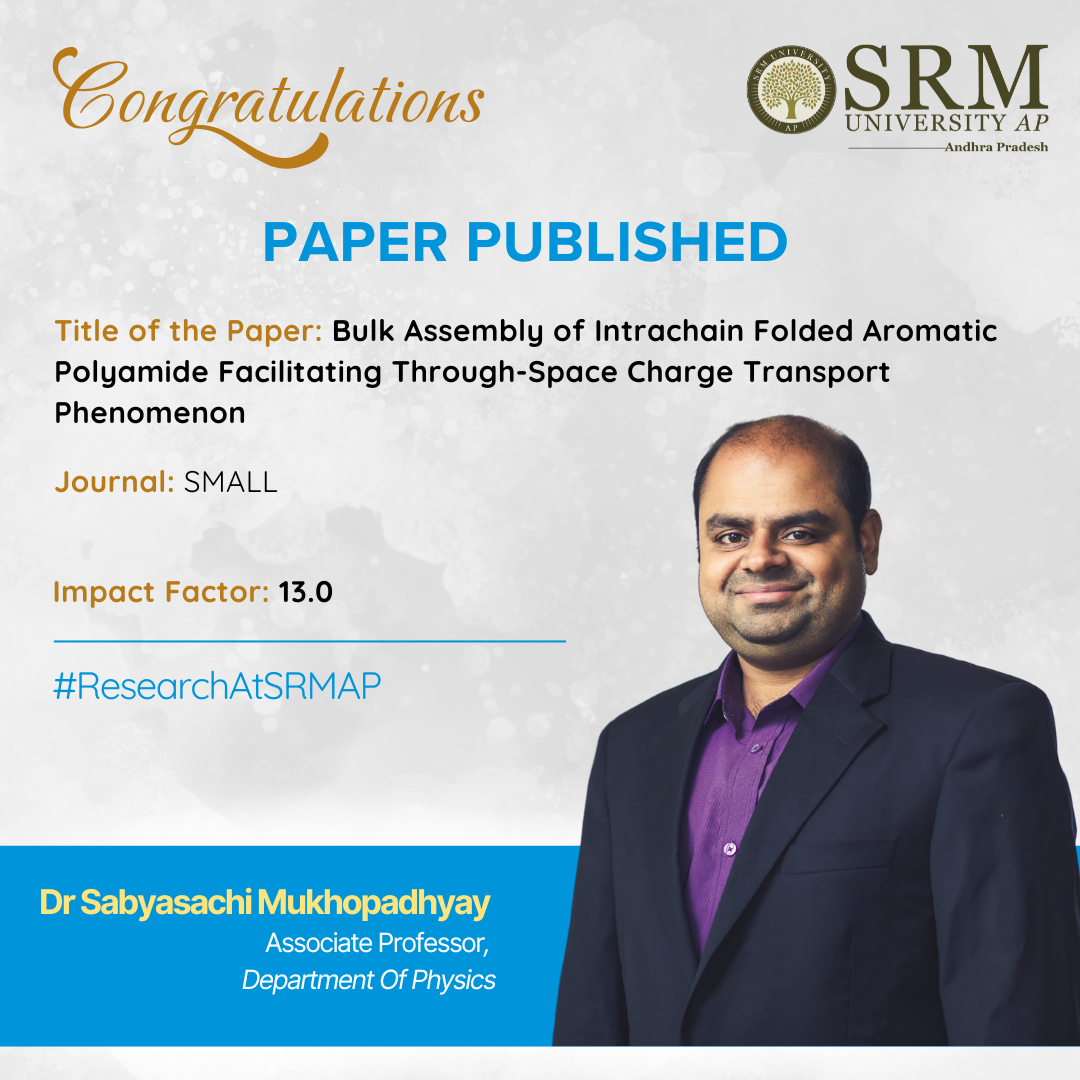 In the quest for next-generation organic electronic materials, researchers have drawn inspiration from nature’s intricate designs. A groundbreaking study titled “Bulk Assembly of Intrachain Folded Aromatic Polyamides Facilitating Through-Space Charge Transport Phenomenon” led by Dr Sabyasachi Mukhopadhyay, Associate Professor in the Department of Physics, introduces a novel class of polymers that mimic the secondary structures of biomolecules. Published in the high-impact Q1 journal SMALL with an Impact Factor of 13.0, this research unveils the potential of intrachain folded aromatic polyamides in facilitating efficient through-space charge transport.
In the quest for next-generation organic electronic materials, researchers have drawn inspiration from nature’s intricate designs. A groundbreaking study titled “Bulk Assembly of Intrachain Folded Aromatic Polyamides Facilitating Through-Space Charge Transport Phenomenon” led by Dr Sabyasachi Mukhopadhyay, Associate Professor in the Department of Physics, introduces a novel class of polymers that mimic the secondary structures of biomolecules. Published in the high-impact Q1 journal SMALL with an Impact Factor of 13.0, this research unveils the potential of intrachain folded aromatic polyamides in facilitating efficient through-space charge transport.Abstract :
This study presents the design and synthesis of periodically grafted aromatic Polyamides capable of intrachain folding, mimicking secondary structures seen in biomolecules. Leveraging the immiscibility between aromatic backbones and Polyethylene glycol (PEG) side chains, the polymers self-assemble into lamellar, phase-separated domains with ordered π-stacking.The structural order is further enhanced by incorporating aromatic guest molecules, enabling efficient through-space charge transport. Structural and morphological investigations via SAXS, WAXS, AFM, and TEM confirm the formation of highly ordered π-domains. Charge transport measurements reveal vertical current densities as high as 10⁻⁴ A/cm² in annealed host–guest complexes, comparable to conventional conjugated polymers, demonstrating the potential of these materials for stable, anisotropic organic electronics.
Practical implementation :
This research provides a new strategy for designing flexible, stable, and efficient organic electronic materials without the need for traditional conjugated polymers. The ability to precisely control the orientation and spacing of conductive regions at
The nanoscale opens doors for:
- Wearable and stretchable electronics
- Flexible sensors and low-power devices
- Organic transistors and memory devices with tunable directionality
- Environmentally stable devices, useful in humid or high-temperature conditions
- These innovations can lower manufacturing costs, enhance sustainability, and enable novel applications in healthcare, IoT, and smart textiles.
This research was a collaborative effort between multiple departments and institutions including Department of Chemical Sciences, IISER Mohali, Department of Physical Sciences, IISER Mohali and Department of Physics, SRM University – AP (Ramkumar K, Dr Sabyasachi Mukhopadhyay) and was supported by Department of Science and Technology – Science and Engineering Research Board (DST-SERB)
Future research plans:
Dr Sabyasachi Mukhopadhyay is working towards “Integrated Center for Organic Electronics” – a multidisciplinary innovation hub focused on designing the next generation of flexible, sustainable, and high-performance electronic materials and devices.
Continue reading → - Insights on Leptogenesis and Dark Matter Production April 30, 2025
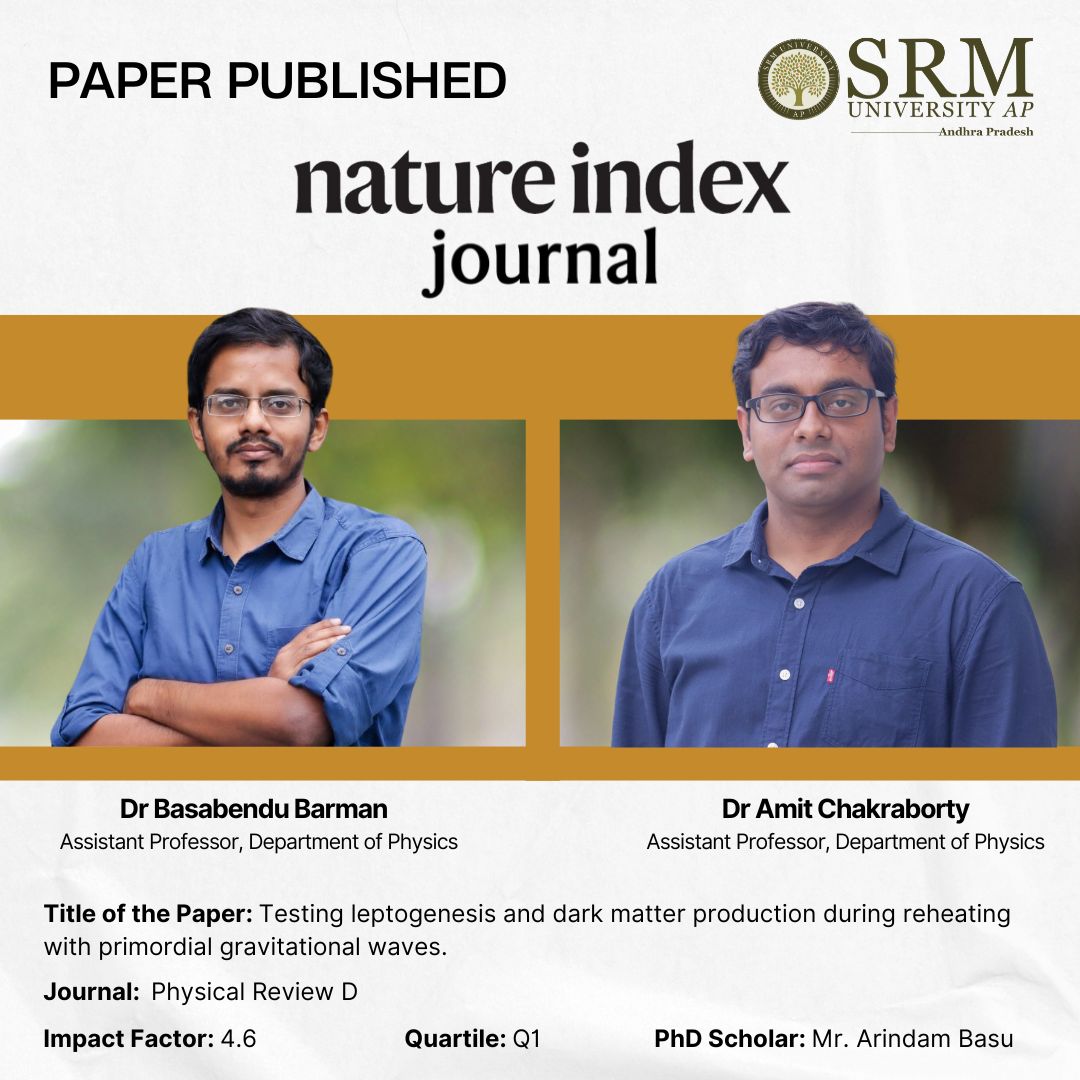 Dr Basabendu, Dr Amit Chakraborty, and Mr Arindam Basu from the Department of Physics at SRM University-AP jointly authored the study titled, “Testing leptogenesis and dark matter production during reheating with primordial gravitational waves” which was published in Physical Review D (Nature Index). The research looks into different monomial potentials and various decay processes of the inflaton field, providing important insights into fundamental cosmic events.
Dr Basabendu, Dr Amit Chakraborty, and Mr Arindam Basu from the Department of Physics at SRM University-AP jointly authored the study titled, “Testing leptogenesis and dark matter production during reheating with primordial gravitational waves” which was published in Physical Review D (Nature Index). The research looks into different monomial potentials and various decay processes of the inflaton field, providing important insights into fundamental cosmic events.Abstract:
We study the generation of baryon asymmetry as well as dark matter (DM) in an extended reheating period after the end of slow-roll inflation. Within the regime of perturbative reheating, we consider different monomial potential of the inflaton field during reheating era. The inflaton condensate reheats the Universe by decaying into the Standard Model (SM) bath either via fermionic or bosonic decay modes. Assuming the leptogenesis route to baryogenesis in a canonical seesaw framework with three right handed neutrinos (RHN), we consider both the radiation bath and perturbative inflaton decay to produce such RHNs during the period of reheating when the maximum temperature of the SM bath is well above the reheating temperature. The DM, assumed to be a SM gauge singlet field, also gets produced from the bath during the reheating period via UV freeze-in. In addition to obtaining different parameter space for such nonthermal leptogenesis and DM for both bosonic and fermionic reheating modes and the type of monomial potential, we discuss the possibility of probing such scenarios via spectral shape of primordial gravitational waves.
Practical Implementations & Social Impact:
Imagine the early universe as a giant, chaotic fireball after the Big Bang. But before things settled down into the stars and galaxies we see today, the universe went through a phase called inflation—a rapid expansion driven by a field called the inflaton. Once inflation ended, the inflation’s energy had to somehow convert into all the particles that make up our universe. This process is called reheating. In this study, we explore what happens if reheating takes longer than usual, extending well beyond what’s typically assumed. We look at different ways the inflaton could decay—either into particles like fermions (similar to electrons) or bosons (like the Higgs boson)—and how this affects the formation of two big cosmic mysteries: the matter-antimatter asymmetry (baryon asymmetry) and dark matter. We analyse how different inflaton decay mechanisms and different types of inflaton energy landscapes (represented by mathematical potentials) influence these processes. Beyond just predicting what parameters could make this scenario work, we also suggest a possible way to test it: by looking at primordial gravitational waves, ripples in spacetime left over from the early universe. Their specific features might reveal hints about how reheating played out, offering a new way to probe the origins of matter and dark matter.
This study is not just about abstract physics—it’s about our origins. Understanding how matter and dark matter formed in the early universe connects directly to our existence and could shape future discoveries in physics, technology, and space exploration. Whether it’s through deep-space telescopes, gravitational wave detectors, the quest to understand the first moments of the universe is one that could transform the way we see our place in the cosmos.
Collaborations:
This work has been done in collaboration with Dr Amit Chakraborty and Mr Arindam Basu from the Department of Physics, SRM University-AP
Future Plans:
A closer look at early universe dynamics by performing more involved simulations.
Connection between particle physics models and early Universe cosmology.
Complementary searches from different experiments in unravelling new physics beyond the Standard Model. Searching for new physics at the energy and intensity frontier.Link: https://journals.aps.org/prd/abstract/10.1103/PhysRevD.111.055016
Continue reading →


